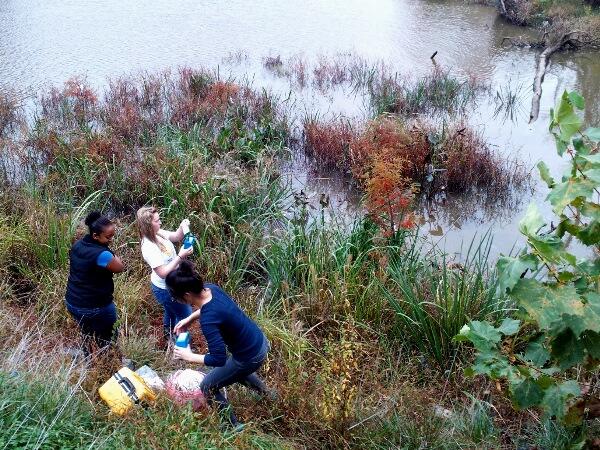
Aug. 19, 2013
The Carbon Awareness Partnership
VCU partners with community to educate students about the effects of rising levels of carbon dioxide
Share this story
We don’t realize how dependent we are on the world around us. But keeping to a steady rhythm beyond what the naked eye can see are intricate and delicate cycles involving carbon, photosynthesis and respiration. Each cycle is considered critical to our survival and life on Earth.
Global climate change, including warming, is, in part, the result of things gone awry with the carbon cycle. Carbon is recycled and reused throughout the biosphere. It travels a steady path and the amount of carbon on Earth is constant. But the burning of fossil fuels, such as coal, oil and natural gas, and other manmade impacts, such as deforestation, have led to the release into the atmosphere of excessive amounts of carbon dioxide from sources that have been buried for millions of years. More and more energy from the sun is being trapped by this build-up of carbon dioxide and other greenhouse gases in the upper atmosphere instead of releasing into space.
To compound the problem, most people know very little about the carbon cycle and its importance.
In response, a team of VCU faculty and students developed the Carbon Awareness Partnership in an effort to make a difference through outreach and education and to increase awareness and understanding of carbon.
The team includes faculty and students in VCU Life Sciences, the Department of Biology in the VCU College of Humanities and Sciences and the VCU School of Education. Anne Wright, assistant professor of biology and coordinator of VCU Life Sciences Outreach Education, leads the effort, which also includes community partners Central Virginia Waste Management Authority; Chesterfield County Anti-Litter Campaign; and Clover Hill, Douglas Freeman, Varina, Highland Springs, J.R. Tucker and Powhatan high schools.
The group set out to develop a program designed to change the way teachers and students learn about the carbon cycle. The result was a carbon capstone/service-learning course, created to train VCU undergraduates in biology to effectively lead a multi-day carbon module investigation for high school classes.
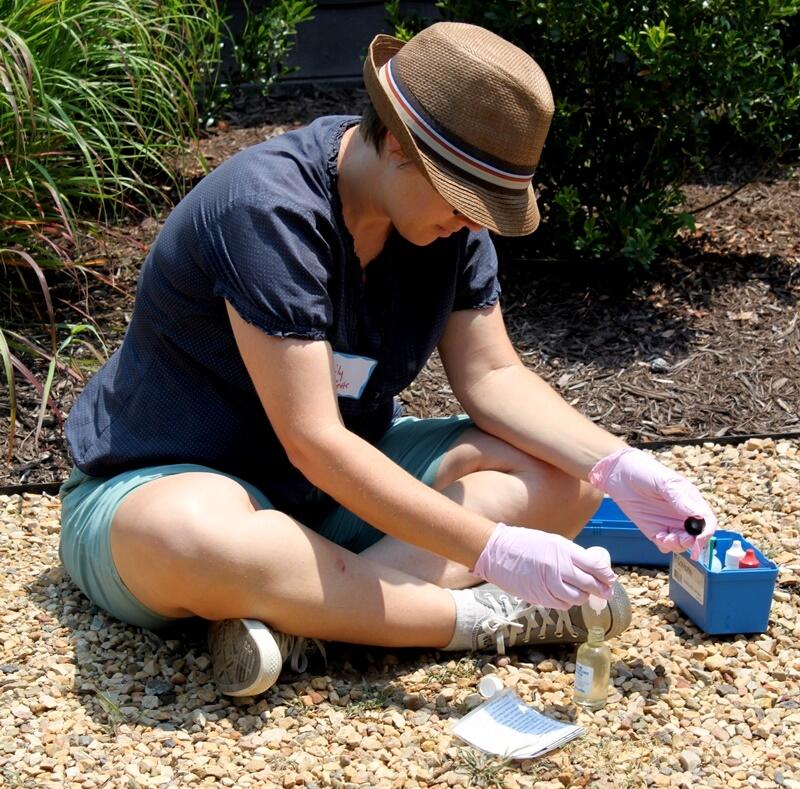
In 2011-2012, for instance, the Carbon Awareness Partnership helped more than 300 high school students and undergraduates gain an in-depth, hands-on understanding of the carbon cycle.
Ann Benjamin, a VCU senior who is working toward her bachelor’s degree in biology with a concentration in pre-medicine, was among the undergraduate students tasked with teaching the high school students about the carbon cycle – a process she herself did not initially fully understand prior to taking the course. But once she was engaged with the program and began to share her knowledge with others, things began to click.
“For the carbon capstone, I had to make sure I understood what the carbon cycle was about and help the high school students learn how important it is as well,” Benjamin said.
“Working with the students was an interesting experience. I felt that it would be really intimidating to bring a new idea to them and they would not care about it. However, once I started teaching the students I found that they were very receptive to me and what I was presenting to them. I felt that since I was able to make the presentations fun and interactive, the students were able to learn something new.”
Local science teacher Michelle Huber, who teaches 9th through 12th graders at Clover Hill High School, was involved with the project and saw firsthand the impact these efforts had on her students.
“The students were mentored by the VCU faculty, undergraduate, graduate and Ph.D. students who were very professional and on-point with relating the information to the students,” Huber said.
“It was great to see these young scientists relate to my students, as well as share educational experiences and pathways with them. The experience was invaluable for the students and teachers involved.”
Lack of carbon awareness
Wright has been working collaboratively with members from the laboratory of S. Leigh McCallister, Ph.D., assistant professor of biology in the VCU College of Humanities and Sciences and the VCU Center for Environmental Studies and an affiliate faculty member in the VCU Rice Center. This includes Eric Hall, a Ph.D. candidate in biology who is developing and teaching the program as a portion of his dissertation; Lindsey Koren, a Ph.D. candidate who provided content and oversight of the project; and Rachel Cooper, a master’s student in the Department of Biology who provided content, blogging expertise and oversight.
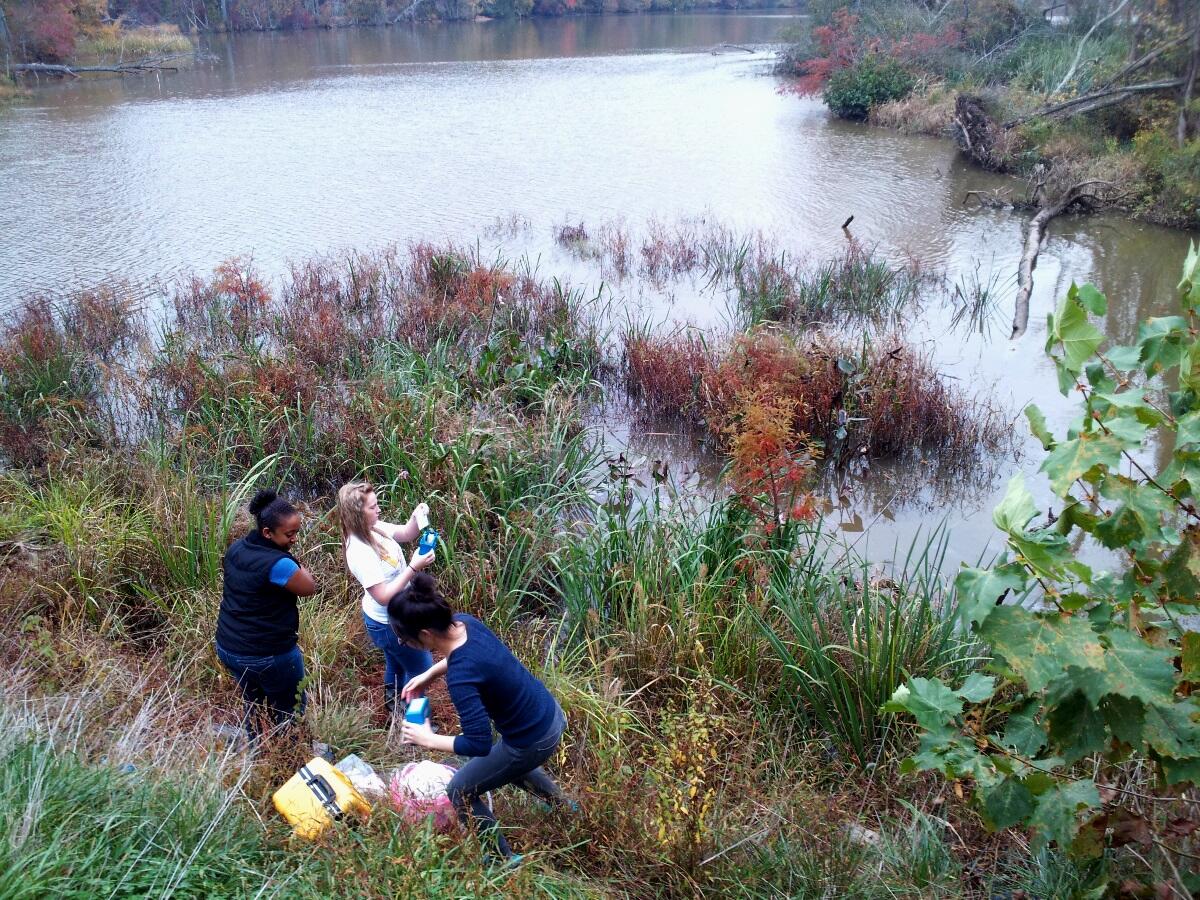
“There is research that shows that students are leaving high school and college with misconceptions of how carbon moves around earth’s surface,” Hall said.
“They don’t really understand the impact the carbon cycle has on their lives whether it be from fossil fuel emissions or the potential to save carbon through recycling – they may not see any reason carbon may be important – they are not able to make those connections,” he said.
“What we are trying to do, is not only teach them the basics about the carbon cycle, but also inform them how it pertains to them and why they should care about it. So they can see the human impacts on the carbon cycle in their everyday lives,” Hall said.
The course also allows undergraduate students to conduct a scientifically relevant carbon research experiment, and produce an academic poster/presentation to disseminate their research and teaching experiences to the greater community.
According to Wright, the reviews and feedback received from the teachers and students in the community high schools have been positive.
“The teachers feel that the program is very integrative – it’s not, here’s the carbon cycle, here’s how it is ruled by either photosynthesis or respiration,” Wright said. “Rather, we’ve developed a way to show the system - where you can actually see it, measure it, test it and do an experiment on it – so it hits lots of things on lots of levels.”
Huber said the program underscored the relevance of carbon in the environment for her high school students.
“My students took away an additional understanding of the carbon cycle and the importance of recycling,” Huber said. “Hands-on experiences always reinforce the concepts and the mesocosms provide just that.”
She added that VCU has provided a mesocosm that is located on the high school’s campus. Huber said that her students will continue their work with quantifying oxygen and carbon dioxide concentrations in their system throughout the year. After this program, the students will consider “macro” scale sources of carbon into the atmosphere as well as “meso/micro” sources from inland water sources.
According to Huber, the mesocosm on the Clover Hill High School campus is also used to identify macroinvertebrates and microorganisms in the system. The type of macroinvertebrates provide an indicator as to the dissolved oxygen concentration in the water system. She said that this leads to discussions about adversely impacted waters and the amount of decomposition present.
“Working with the VCU staff on the Carbon Awareness Partnership was an outstanding experience,” Huber said. “The students were able to collect data on lower-carbon dioxide producing mesocosm systems as well as higher-carbon dioxide mesocosm producing systems. Prior to the Carbon Awareness Partnership, I don't believe the students made this connection and correlated photosynthesis and respiration to carbon dioxide concentrations in the atmosphere.”
“This was an additional pathway that we talk about, but the students were really able to quantify and consider in addition to the ‘macro’ scale industrial sources of carbon dioxide that we automatically consider.”
Science beneath the surface
To visualize the carbon cycle, the VCU undergraduates and high school students set up an experiment at the VCU Rice Center (or their home school) and take measurements. At the VCU Rice Center two giant 300-gallon cattle tanks filled with water (called mesocosms) serve as experimental systems where data can be collected to investigate how carbon is cycled. The tanks are in two different environments – an open field, exposed to the sun, and a shaded forest. The data collected is then analyzed to better illustrate how carbon is processed in the water found inside the two different tanks.
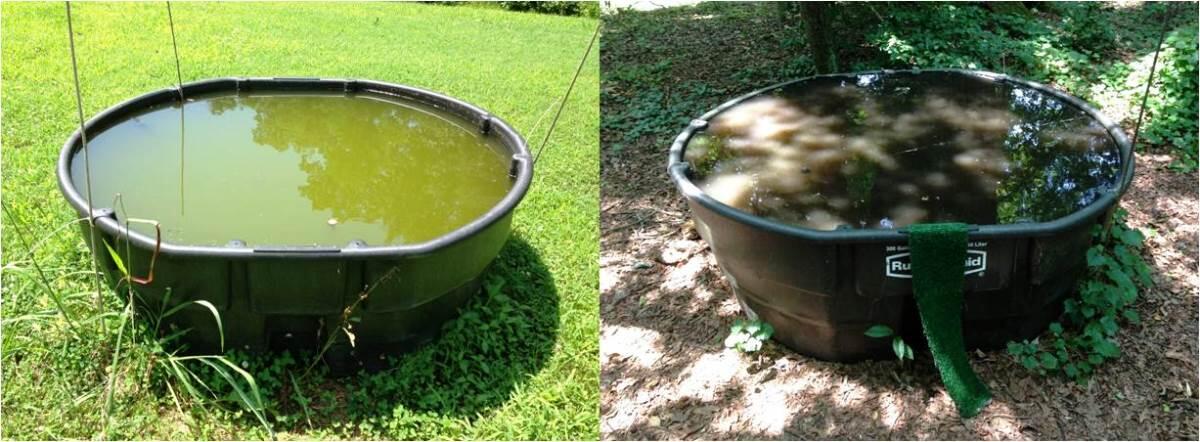
The mesocosm located in the sun is dominated by photosynthesis. It’s green, and full of algae. That’s what you can see on the surface. What the students learn through sampling the water and running measurement tests is that it’s dissolved oxygen levels are consistently high, and the carbon dioxide levels are consistently low. Hall said that’s because the algae are photosynthesizing: taking in carbon dioxide and releasing oxygen as a by-product of photosynthesis. That’s the carbon cycle at work.
The second mesocosm is located in a shaded forest. On the surface students see dark water – black or dark brown and it’s much cooler. What’s happening inside is the opposite of the sun mesocosm. Here, according to Hall, the bacteria and heterotrophs are breaking down organic matter that has fallen in from the surrounding forest, so they are respiring carbon. They are taking in oxygen and releasing carbon dioxide as a by-product of their respiration. The oxygen levels in this tank are usually so low they can barely be measured.
“In contrast to each other, they provide the students with environmental applications to photosynthesis and respiration where they can measure directly the inputs and outputs and make the comparison between the mesocosms,” said Hall.
The undergraduates and high school students sample both mesocosms. However, undergraduates generally engage in another layer of further experimentation. Last spring, Hall and his team had the undergraduates examine vernal pools and in the fall, a wetland, so once again, they were able to draw comparisons between the environments. The students keep a blog about their progress and field work and are required to do a blog entry each week and read each other’s entries.

“Because our undergrads must teach and do a research project that relates to contemporary ecological issues, they walk away with experience giving a classroom presentation, conducting an independent research experiment under our supervision and creating an academic poster which they present at a scientific conference,” Hall said. In the past, the scientific conferences have included the Rice Center Annual Research Symposium and the Mid-Atlantic Chapter of the Ecological Society of America (ESA).
Benjamin, one of the VCU undergraduates who taught the carbon cycle to the high school students, added that since completing the Carbon Awareness Partnership, she has tried to decrease her carbon footprint.
“I learned about the different types of carbon and how they impact our environment by doing a research project on mesocosms at VCU Rice Center,” she said. “Before the program I had no idea what a mesocosm was, but after completing the research project I learned various techniques and instruments used to determine the amount of carbon were in each of them. I have also been able to teach my family and friends about the carbon cycle.”
Currents of Change
Earlier this year, the Carbon Awareness Partnership was recognized by the Council for Community Engagement with the Currents of Change Service Award and the team was presented with the 2013 Overall Currents of Change Award for the project that best demonstrated integration of three key areas: teaching, community-engaged service and community-engaged research.
“The center has provided much more then training and equipment, and has visited my classroom on multiple occasions to personally teach my students the importance of carbon awareness and to educate my students on the importance of water quality,” said Mindy VanDevelder, a biology teacher at Varina High School.
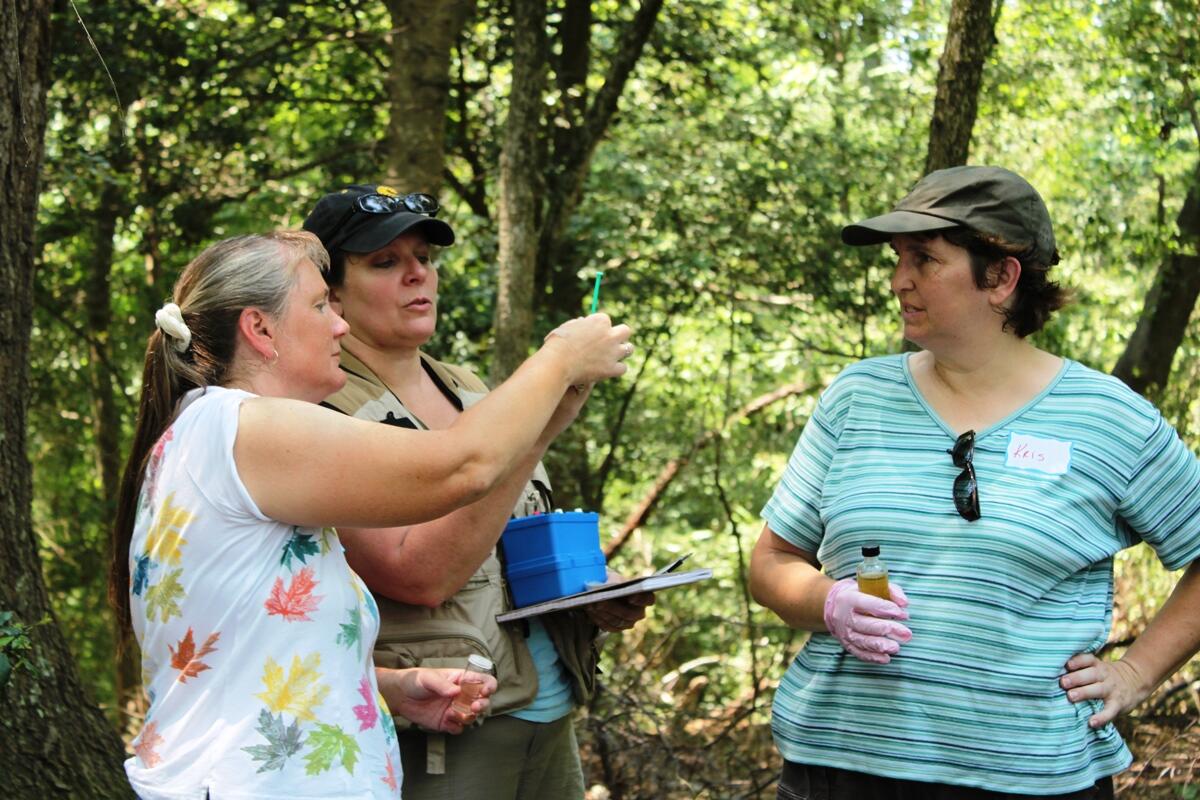
VanDevelder has participated in a number of outreach workshops through the VCU Rice Center during the past six years, including the Carbon Awareness Partnership.
“This program has provided me with the creativity and resources I need to teach my students effectively about some difficult topics in environmental science,” VanDevelder said. “Anne Wright has provided Varina High School students several opportunities to visit the Rice Center for a hands-on carbon experience where my students learned the differences between allochthonous and autochthonous carbon sources and sinks, performed actual research, and, most importantly, got them a little dirty and provided them the experience of what it is like to be an environmental scientist for a day.
“These are community experiences that are desperately needed in today's science classroom, and I am grateful for the opportunities I have as a science teacher to work with the VCU Rice Center.”
The Carbon Awareness Partnership is supported by a grant from Dominion Virginia Power and the Dominion Foundation.
Moving forward, the team plans to gather quantitative data to measure knowledge gains. They have received approval to start analyzing pre- and post-survey data on participants in the program. During the next year, Hall said the team will quantify the project’s success advancing content knowledge of the high school students, high school teachers and the VCU undergraduates.
Subscribe for free to the weekly VCU News email newsletter at http://newsletter.news.vcu.
Subscribe to VCU News
Subscribe to VCU News at newsletter.vcu.edu and receive a selection of stories, videos, photos, news clips and event listings in your inbox.









